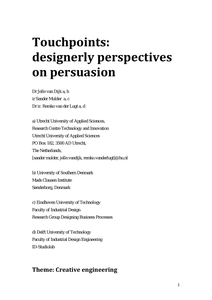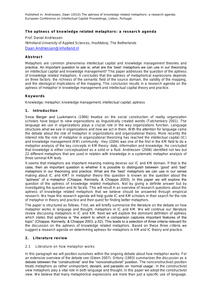Social media, such as Facebook, offer brands the opportunity to reach their target audience in a less obtrusive way than traditional media, through sponsored posts. Regulations require marketers to explicitly inform consumers about the commercial nature of these posts. This study addresses the effects of sponsorship disclosures by means of a 2 (no disclosure vs. the sponsorship disclosure ‘Sponsored’) × 2 (source: celebrity endorser vs. brand) experiment. Results suggest that a sponsorship disclosure only influences the use of persuasion knowledge when the post is disseminated by a celebrity. Moreover, a disclosure starts a process in which the recognition of advertising (i.e., the activation of conceptual persuasion knowledge) causes consumers to develop distrusting beliefs about the post (i.e., higher attitudinal persuasion knowledge), and in turn, decreases their intention to engage in electronic word of mouth.
LINK
Our approach builds on both the design traditions of participatory design and embodiment. We attempt to connect these traditions to the existing body of knowledge on persuasion. First we describe some basic theoretical concepts and infer how they influence persuasive design. Then we present a basic framework with which we intend to address the different abstraction layers involved. Finally, we discuss the principal differences and meeting areas between the disciplines of design and communication, ending up with some considerations for a persuasion toolbox that is intended to help communication professionals and designers effectively design behavior change interventions that fit the messy lives of people in the real world
DOCUMENT

Conceptual metaphors play a vital role in our ability to think in abstract terms like knowledge. Metaphors structure and give meaning to the concept of knowledge. They hide and highlight certain characteristics. The choice of metaphor when reasoning about knowledge is therefore of vital importance for knowledge management (KM). This paper explores the possibility of introducing new knowledge metaphors to the field of KM. Based on a ‘wish list’ of characteristics of knowledge they want to highlight, the authors choose to explore the Knowledge as a Journey metaphor as a new metaphor for knowledge. This results in new insights regarding knowledge sharing, acquisition, retention, and innovation.
DOCUMENT

Conceptual metaphors play a vital role in our ability to think in abstract terms like knowledge. Metaphors structure and give meaning to the concept of knowledge. They hide and highlight certain characteristics. The choice of metaphor when reasoning about knowledge is therefore of vital importance for knowledge management (KM). This paper explores the possibility of introducing new knowledge metaphors to the field of KM. Based on a ‘wish list’ of characteristics of knowledge they want to highlight, the authors choose to explore the Knowledge as a Journey metaphor as a new metaphor for knowledge. This results in new insights regarding knowledge sharing, acquisition, retention, and innovation.
DOCUMENT

People tend to disclose personal identifiable information (PII) that could be used by cybercriminals against them. Often, persuasion techniques are used by cybercriminals to trick people to disclose PII. This research investigates whether people can be made less susceptible to persuasion by reciprocation (i.e., making people feel obligated to return a favour) and authority, particularly in regard to whether information security knowledge and positive affect moderate the relation between susceptibility to persuasion and disclosing PII. Data are used from a population-based survey experiment that measured the actual disclosure of PII in an experimental setting (N = 2426). The results demonstrate a persuasion–disclosure link, indicating that people disclose more PII when persuaded by reciprocation, but not by authority. Knowledge of information security was also found to relate to disclosure. People disclosed less PII when they possessed more knowledge of information security. Positive affect was not related to the disclosure of PII. And contrary to expectations, no moderating effects were found of information security knowledge nor positive affect on the persuasion–disclosure link. Possible explanations are discussed, as well as limitations and future research directions. Uitgegeven door Sage, APA beschrijving: van der Kleij, R., van ‘t Hoff—De Goede, S., van de Weijer, S., & Leukfeldt, R. (2023). Social engineering and the disclosure of personal identifiable information: Examining the relationship and moderating factors using a population-based survey experiment. Journal of Criminology, 56(2-3), 278-293. https://doi.org/10.1177/26338076231162660
DOCUMENT
Games are designed with different objectives in mind. Some primarily for entertainment, others also to educate, motivate or persuade its players. Games with the latter objective, that of persuasion, are designed not only to be entertaining, but also with the intent to shape how players think and feel about issues in reality. However, despite the growing interest in persuasive games, we still lack the design insights and strategies that support their production, particularly for those using immersive technologies. To address this gap, we organize a hands-on workshop and bring together academic and industry experts to explore persuasive game design. Through making we generate knowledge in the form of insights and examplar work, and subsequently formulate best-practises and design strategies for future design and research.
DOCUMENT
Background: There is increasing interest in the role that technology can play in improving the vitality of knowledge workers. A promising and widely adopted strategy to attain this goal is to reduce sedentary behavior (SB) and increase physical activity (PA). In this paper, we review the state-of-the-art SB and PA interventions using technology in the office environment. By scoping the existing landscape, we identified current gaps and underexplored possibilities. We discuss opportunities for future development and research on SB and PA interventions using technology. Methods: A systematic search was conducted in the Association for Computing Machinery digital library, the interdisciplinary library Scopus, and the Institute of Electrical and Electronics Engineers Xplore Digital Library to locate peer-reviewed scientific articles detailing SB and PA technology interventions in office environments between 2009 and 2019. Results: The initial search identified 1130 articles, of which 45 studies were included in the analysis. Our scoping review focused on the technologies supporting the interventions, which were coded using a grounded approach. Conclusion: Our findings showed that current SB and PA interventions using technology provide limited possibilities for physically active ways of working as opposed to the common strategy of prompting breaks. Interventions are also often offered as additional systems or services, rather than integrated into existing office infrastructures. With this work, we have mapped different types of interventions and provide an increased understanding of the opportunities for future multidisciplinary development and research of technologies to address sedentary behavior and physical activity in the office context
DOCUMENT

In order to design effective Persuasive Technology (PT) interventions, it is essential that designers understand the multitude of factors that lead to behavioral change, rather than guessing at a solution or imitating successful techniques without understanding why. The few available PT design frameworks solely distinguish behavioral determinants on an individual (micro) level (e.g., motivation), whereas successfully persuading a user is a multifaceted and complex task depending also on factors on a meso (e.g., available resources) and macro (e.g., social support and praise) level. We developed an analysis grid that enables PT designers to acknowledge the multifaceted character of determinants leading to behavioral change and select appropriate PT channels and strategies, preventing the failure of PT design. This analysis grid was validated in a case study in which we designed a PT intervention aimed at reporting minor crime incidents among citizens.
DOCUMENT

Metaphors are common phenomena intellectual capital and knowledge management theories and practice. An important question to ask is: what are the ‗best‘ metaphors we can use in our theorizing on intellectual capital and knowledge management? This paper addresses the question of the aptness of knowledge related metaphors. It concludes that the aptness of metaphorical expressions depends on three factors: the richness of the semantic field of the source domain, the validity of the mapping, and the ideological implications of the mapping. This conclusion results in a research agenda on the aptness of metaphor in knowledge management and intellectual capital theory and practice.
DOCUMENT

Behaviour Change Support Systems (BCSS), already running for the 10th time at Persuasive Technology, is a workshop that builds around the concept of systems that are specifically designed to help and support behaviour change in individuals or groups. The highly multi-disciplinary nature of designing and implementing behaviour change strategies and systems for the strategies has been in the forefront of this workshop from the very beginning. The persuasive technology field is becoming a linking pin connecting natural and social sciences, requiring a holistic view on persuasive technologies, as well as multi-disciplinary approach for design, implementation, and evaluation. So far, the capacities of technologies to change behaviours and to continuously monitor the progress and effects of interventions are not being used to its full potential. The use of technologies as persuaders may shed a new light on the interaction process of persuasion, influencing attitudes and behaviours. Yet, although human- computer interaction is social in nature and people often do see computers as social actors, it is still unknown how these interactions re-shape attitude, beliefs, and emotions, or how they change behaviour, and what the drawbacks are for persuasion via technologies. Humans re-shape technology, changing their goals during usage. This means that persuasion is not a static ad hoc event but an ongoing process. Technology has the capacity to create smart (virtual) persuasive environments that provide simultaneously multimodal cues and psycho-physiological feedback for personal change by strengthening emotional, social, and physical presence. An array of persuasive applications has been developed over the past decade with an aim to induce desirable behaviour change. Persuasive applications have shown promising results in motivating and supporting people to change or adopt new behaviours and attitudes in various domains such as health and wellbeing, sustainable energy, education, and marketing. This workshop aims at connecting multidisciplinary researchers, practitioners and experts from a variety of scientific domains, such as information sciences, human-computer interaction, industrial design, psychology and medicine. This interactive workshop will act as a forum where experts from multiple disciplines can present their work, and can discuss and debate the pillars for persuasive technology.
MULTIFILE
